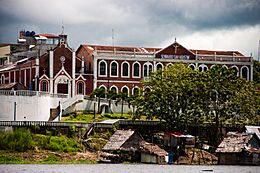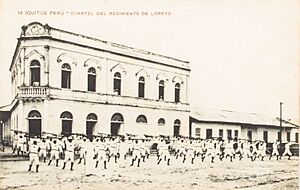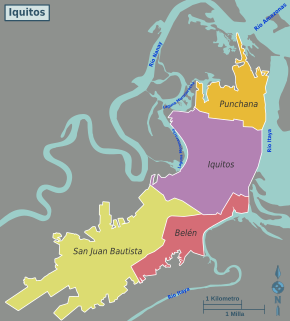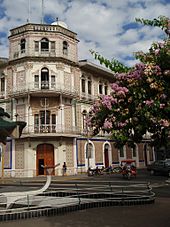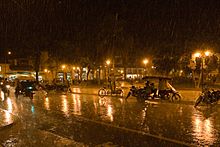Iquitos facts for kids
Quick facts for kids
Iquitos
San Pablo de Nuevo Napeanos
|
|||
|---|---|---|---|
|
From top to bottom and from left to right: Iquitos Cathedral; Old Hotel Palace; Belen Market; Boulevard of Iquitos; Coronel FAP Francisco Secada Vignetta International Airport; Chapel of Consolation and Saint Augustine Seminary; One of the main ports of Iquitos; Nanay Bridge; Northern Area of Metropolitan Iquitos; Historical Ship Ayapua Museum; José Abelardo Quiñones Avenue.
|
|||
|
|||
| Nickname(s):
Capital of the Peruvian Amazon, The Amazonian Island
|
|||
| Motto(s):
Carpent tua poma nepotes (Latin: Your children will harvest your fruits)
|
|||
| Country | |||
| Region | Loreto | ||
| Province | Maynas | ||
| District | Iquitos | ||
| Settled | 1624 | ||
| Incorporated | 1866 | ||
| Government | |||
| • Type | Local government | ||
| • Body | Provincial Municipality of Maynas | ||
| Area | |||
| • City | 1,213 km2 (468.5 sq mi) | ||
| • Land | 784 km2 (302.6 sq mi) | ||
| • Water | 340 km2 (132 sq mi) | ||
| Elevation | 104 m (341 ft) | ||
| Population | |||
| • Estimate
(2023)
|
491,000 | ||
| • Rank | 9th | ||
| • Metro | 510,000 | ||
| Demonym(s) | Iquiteño | ||
| Time zone | UTC-5 (PET) | ||
| UBIGEO |
1601
|
||
| Area code(s) | 65 | ||
| ISO 3166 code | PE-LOR | ||
| Climate | Af | ||
| Website | www.munimaynas.gob.pe | ||
Iquitos is a major city in Peru. It is the capital of Maynas Province and the Loreto Region. It is the largest city in the Peruvian Amazon, located east of the Andes Mountains. Iquitos is also the ninth-most populated city in Peru.
What makes Iquitos special is that it is the largest city in the world that cannot be reached by road. You can only get there by river or by air. This unique location has earned it the nickname "Capital of the Peruvian Amazon" and "The Amazonian Island."
The city sits in the vast Amazon Basin. It is surrounded by the Amazon River, Nanay River, and Itaya River. Together, these rivers form the Port of Iquitos. The city and its surrounding areas make up the Iquitos metropolitan area, which has over 470,000 people. This area includes four main districts: Iquitos, Punchana, Belén, and San Juan Bautista.
Indigenous people have lived in this area for a very long time. Spanish records show that Iquitos was first settled around 1757. Spanish Jesuit missionaries gathered local Napeano and Iquito natives to live there. They called the settlement San Pablo de Napeanos.
In the late 1800s, Iquitos became very important during the Amazon rubber boom. It was the main place for exporting rubber from the Amazon. The city's economy relied heavily on the Peruvian Amazon Company (PAC). This company, led by Julio César Arana, treated indigenous workers very poorly. Eventually, an investigation exposed these problems. Also, rubber seeds were secretly taken from the region and grown on plantations in Southeast Asia. This made the price of Peruvian rubber drop. When the rubber industry declined, many people left Iquitos.
During the rubber boom (1880–1914), many Europeans came to Iquitos. They brought their architecture and culture, building things like an opera house and a Jewish cemetery. Later in the 20th century, Iquitos found new ways to support its economy. The region now exports timber, fish, oil, minerals, and farm crops. Tourism and local crafts also bring money to the city.
Contents
History of Iquitos
Early Settlements
For thousands of years, Amerindian people lived in the Iquitos area. When Europeans arrived, the Napeano and Iquito tribes lived here. They were nomadic, moving with the seasons and living near the rivers. The city's name, Iquitos, comes from the Iquito people. They used to live along rivers like the Pastaza, Arabela, Tigre, Nanay, and Curaray. Later, they moved closer to the Nanay, Amazon, Itaya rivers, and Lake Moronacocha.
Between 1638 and 1769, Jesuit missionaries from Quito created special settlements called reducciones (reductions). They encouraged the Iquitos and other native tribes to live in these missions. About 161 Jesuit missionaries worked to convert and educate the natives of the Amazon region. They helped gather natives along the Marañon River into missions. Here, the natives learned farming and other skills.
From 1730 onwards, the Jesuits founded several Iquitos Missions near the Napo and Amazon rivers. These were mainly populated by the Iquito natives. Father José Bahamonde named and founded many of these missions. In 1767, the King of Spain, Charles III of Spain, ordered the Jesuits to leave South America. This created a power gap, and Brazilian groups attacked the undefended missions. To stop this, the King of Spain created the General Command of Maynas in 1802. This helped protect the Spanish Amazon from invaders.
Becoming a Peruvian City
In the early 1800s, after Peru became independent, Peru, Ecuador, Colombia, and Brazil all claimed parts of the Northwestern Amazon Basin. This area was mostly jungle, home to nomadic native groups. There were also small trading villages with some native, white, and mixed-race people. Brazil had many villages along the Amazon River leading to the Atlantic Ocean.
Peru wanted to control its Amazonian territories. So, it set up military posts in isolated trading villages. It also encouraged Peruvian colonists to move there. To avoid problems with Brazil, Peru signed a treaty in 1851. This treaty allowed free navigation and trade along the Amazon River for both countries.
Because of this treaty, Peruvian President Ramon Castilla created the Military and Political Department of Loreto in 1861. He ordered a river port to be built on the Amazon River. The trading village of Iquitos was chosen. On January 5, 1864, three Peruvian Navy steamships arrived in Iquitos. This date marks the founding of Iquitos as Peru's first river port. A shipyard was built, and Iquitos grew quickly. It became the capital of the Department of Loreto in 1897. Peru was then able to control most of the Amazon region it claimed.
The Rubber Boom and Its Impact
Starting in the 1900s, Iquitos became very rich because of the rubber industry. This period is known as the rubber boom. Thousands of people, mostly young men, came from all over the world hoping to get rich from rubber. Some became successful merchants and bankers. Many European men married indigenous women and started families in Iquitos. These immigrants brought European styles, music, and architecture to the city. They even built an opera house.
By 1900, there were 25 different companies in Iquitos dealing with rubber. Important citizens like Julio César Arana and Luis Felipe Morey started these businesses. These rubber entrepreneurs were involved in local politics. They helped fund the city's growth. For example, Luis F. Morey became a senator for Loreto, and Arana became the city's mayor. A census in 1903 showed that Iquitos had 9,438 people. Many of them were foreigners.
However, the rubber boom also had a dark side. Some rubber tappers carried out slave raids, killing many indigenous people. Children and young women were often captured and sold in cities like Iquitos.
The rubber boom ended when Henry Wickham, a Briton, smuggled rubber seeds out of the Amazon. These seeds were used to start rubber plantations in British colonies in Asia and Africa. This meant rubber could be produced much cheaper elsewhere. Also, a report by British consul Roger Casement in 1913 revealed terrible abuses against indigenous workers by the Peruvian Amazon Company (PAC). This company, owned by Julio César Arana, forced workers into harsh conditions. Casement wrote that "The entire Indian population is enslaved." This investigation led to changes and the company's eventual closure.
With the decline of rubber, Iquitos continued as an important trading port. It started to focus on timber, oil, minerals, and farm products.
Among the immigrants during the rubber boom were Sephardic Jews from Morocco. Many of these men married local women and started families. They built a synagogue and a Jewish cemetery. Generations later, most descendants were not practicing Jews. However, in the 1990s, some descendants began to revive their Jewish heritage. Many have since moved to Israel.
In 2012, a special plaque was placed in Iquitos to celebrate the Amazon River and rainforest. They were recognized as one of the Seven Natural Wonders of the World. This plaque was made in Germany.
Geography of Iquitos


Iquitos is in northeastern Peru, in the Loreto Region. It is the northernmost city in Peru. The city covers about 369 square kilometers. It includes the districts of Belén, Punchana, and San Juan Bautista.
The city is surrounded by the Amazon, Nanay, and Itaya rivers. Iquitos is on the left bank of the Amazon River. This river is vital for the city's economy, especially for trade and transport. The Itaya and Nanay rivers limit how much the city can expand in those directions. New buildings are mostly growing towards the south. There are also several lagoons and lakes near Iquitos, like Moronococha Lake. These water bodies make the city feel like a large island.
Climate in Iquitos
Iquitos has a tropical rainforest climate. This means it has constant rainfall throughout the year, with no distinct dry season. The wet season is from November to May. March and April have the most rain. In May, the Amazon River reaches its highest levels.
The drier, sunnier season is during the winter months. Even then, there can be some heavy rain. Iquitos gets more rain than cities like Ayacucho, Cusco, or Lima. The city's temperature can vary, and it sometimes experiences a "urban heat island" effect. This means the city's heat can get trapped at night by buildings and pavement.
| Climate data for Iquitos, Peru (1961–1990, extremes 1947–present) | |||||||||||||
|---|---|---|---|---|---|---|---|---|---|---|---|---|---|
| Month | Jan | Feb | Mar | Apr | May | Jun | Jul | Aug | Sep | Oct | Nov | Dec | Year |
| Record high °C (°F) | 42.2 (108.0) |
37.0 (98.6) |
42.2 (108.0) |
36.2 (97.2) |
39.0 (102.2) |
35.2 (95.4) |
37.8 (100.0) |
41.1 (106.0) |
38.4 (101.1) |
37.8 (100.0) |
37.4 (99.3) |
36.5 (97.7) |
42.2 (108.0) |
| Mean daily maximum °C (°F) | 31.6 (88.9) |
31.7 (89.1) |
31.9 (89.4) |
31.0 (87.8) |
30.6 (87.1) |
30.4 (86.7) |
30.9 (87.6) |
31.6 (88.9) |
32.1 (89.8) |
31.9 (89.4) |
31.9 (89.4) |
31.7 (89.1) |
31.4 (88.5) |
| Daily mean °C (°F) | 25.9 (78.6) |
25.7 (78.3) |
25.7 (78.3) |
25.4 (77.7) |
25.8 (78.4) |
25.1 (77.2) |
24.9 (76.8) |
25.4 (77.7) |
26.2 (79.2) |
26.5 (79.7) |
26.6 (79.9) |
26.5 (79.7) |
25.8 (78.4) |
| Mean daily minimum °C (°F) | 22.1 (71.8) |
22.0 (71.6) |
22.1 (71.8) |
22.1 (71.8) |
21.9 (71.4) |
21.3 (70.3) |
20.8 (69.4) |
21.1 (70.0) |
21.4 (70.5) |
21.8 (71.2) |
22.1 (71.8) |
23.2 (73.8) |
21.8 (71.2) |
| Record low °C (°F) | 17.0 (62.6) |
18.0 (64.4) |
18.0 (64.4) |
17.8 (64.0) |
17.5 (63.5) |
16.0 (60.8) |
14.7 (58.5) |
15.5 (59.9) |
16.8 (62.2) |
17.0 (62.6) |
17.2 (63.0) |
18.3 (64.9) |
14.7 (58.5) |
| Average rainfall mm (inches) | 279.0 (10.98) |
226.7 (8.93) |
279.0 (10.98) |
309.8 (12.20) |
273.7 (10.78) |
190.1 (7.48) |
181.9 (7.16) |
164.6 (6.48) |
189.0 (7.44) |
241.9 (9.52) |
260.2 (10.24) |
282.4 (11.12) |
2,878.3 (113.32) |
| Average rainy days (≥ 1.0 mm) | 14 | 13 | 12 | 13 | 13 | 13 | 12 | 11 | 10 | 12 | 12 | 13 | 148 |
| Average relative humidity (%) | 80 | 81 | 80 | 83 | 83 | 81 | 81 | 80 | 77 | 78 | 79 | 80 | 80 |
| Mean monthly sunshine hours | 167.4 | 149.7 | 151.9 | 159.0 | 173.6 | 189.0 | 213.9 | 226.3 | 213.0 | 198.4 | 180.0 | 158.1 | 2,180.3 |
| Mean daily sunshine hours | 5.4 | 5.3 | 4.9 | 5.3 | 5.6 | 6.3 | 6.9 | 7.3 | 7.1 | 6.4 | 6.0 | 5.1 | 6.0 |
| Source 1: NOAA, Meteo Climat (record highs and lows) | |||||||||||||
| Source 2: Deutscher Wetterdienst (mean temperatures 1949–1956, precipitation days 1970–1990, humidity 1951–1969, and sun) | |||||||||||||
Natural Hazards
The biggest natural hazard in Iquitos is flooding. In 2012, there was a major flood that affected many areas. The Amazon River's water level rose significantly due to heavy rains. This caused damage and flooded streets in Iquitos.
Other hazards include heat waves, where temperatures can reach over 37°C (99°F). Sometimes, cold air from other parts of the continent can cause "cold waves." This brings a drop in temperature, rain, and thunderstorms. Earthquakes are very rare in Iquitos.
Ecology and Wildlife
Iquitos is in the Peruvian Amazon, so it has a very green landscape with lots of different plants and animals. There are 850 species of plants, including 22 types of palms and many orchids. These plants make the city's urban areas feel like a forest.
The forests around Iquitos are home to 130 types of mammals, 330 bird species, 150 reptile and amphibian species, and 250 fish species. You can even see bull sharks in the Amazon River near Iquitos. They travel all the way from the Atlantic Ocean!
The forests around Iquitos are called várzea forests or Iquitos varzea. These areas flood easily during heavy rain. This natural cycle helps bring nutrients to the rivers. The city works to protect this amazing biodiversity.
Natural Reserves and Zoos
Protecting nature is very important in Iquitos.
- The Allpahuayo-Mishana National Reserve is a protected area with incredible biodiversity. It's about 20 km (12 miles) from Iquitos. This reserve has unique white sand forests and is home to many rare animals. These include different types of monkeys and birds. The Iquitos gnatcatcher, a small bird, is a symbol of Iquitos.
- The Quistococha Tourist Complex is about 6 km (4 miles) from Iquitos. It has a natural forest, a small zoo, a snake house, an aquarium, and an artificial beach.
- The Pilpintuwasi butterfly zoo is in Padre Cocha, Iquitos. It has over 40 species of insects, especially butterflies. Next to it is the Amazon Animal Orphanage, which rescues animals.
Population of Iquitos
| Historical population | ||
|---|---|---|
| Year | Pop. | ±% |
| 1808 | 171 | — |
| 1842 | 200 | +17.0% |
| 1860 | 300 | +50.0% |
| 1862 | 431 | +43.7% |
| 1864 | 648 | +50.3% |
| 1876 | 1,475 | +127.6% |
| 1903 | 9,438 | +539.9% |
| 1928 | 22,575 | +139.2% |
| 1961 | 57,772 | +155.9% |
| 1964 | 76,400 | +32.2% |
| 1972 | 110,402 | +44.5% |
| 1981 | 178,738 | +61.9% |
| 1993 | 274,759 | +53.7% |
| 2007 | 370,962 | +35.0% |
| 2012 | 457,865 | +23.4% |
| 2015 | 471,993 | +3.1% |
In 1808, Iquitos was a small village with only 171 people. By 1842, it had just over 200 residents. The population grew slowly at first. In 1864, there were 648 people, many of them mixed-race families who had moved there to escape attacks on their villages.

During the rubber boom in 1903, the population jumped to 9,438 people. Many of these were foreigners from Spain, Brazil, China, Portugal, and other countries. Today, Iquitos is the largest city in the Peruvian Amazon. In 2007, it had over 406,000 residents.
Iquitos Metropolitan Area
Iquitos is the main urban center of the Iquitos Metropolitan Area. This area is made up of four districts that are very populated in the city. Rural areas are further away from the city center. The Iquitos District is where the city first started.
The four districts are:
- Iquitos District (163,594 people): This is the main district and the most visited by tourists. The center of Iquitos is here, with most of the city's economic, cultural, and entertainment activities. Key places include the Plaza de Armas, the Casa de Fierro, the Iglesia Matriz, and the Boulevard de Iquitos.
- Belén District (74,551 people): This district is known for its busy markets and the Belen Neighborhood, often called the "Venice" of Iquitos because of its houses on stilts over the water. It was created in 1999.
- Punchana District (85,179 people): This is the northern district, created in 1987. It is known for its port activities and the Bellavista-Nanay market.
- San Juan Bautista District (124,143 people): Also called San Juan, this is the largest district. It is constantly growing towards the south. It also includes areas outside urban Iquitos, like the Quistococha Resort and Zoo. This district has tourist spots like the San Juan Craft Market and the beaches of Santa Clara and St. Thomas.
Economy of Iquitos
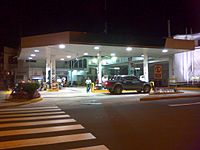

Iquitos is the main center for business, tourism, and industry in the Amazon rainforest. It acts as a gateway to the Peruvian Amazon. The city's economy is supported by industries like timber, petroleum, gas, and fishing. The Belen Market is a very busy place for trade.
Even though the rubber boom ended, Iquitos has continued to grow. The petroleum industry, though outside the city, has greatly influenced its development. Trade has also helped the city expand. In San Juan Bautista, the economy relies on farming (like sugar cane and pijuayo), fish, poultry, and livestock.
Iquitos has many shops, from large malls to small minimarkets. These are especially strong on main avenues like Prospero and Arica. Many companies operate in Iquitos, including banks, retail stores, and international brands. In the future, more large companies are expected to open stores in Iquitos.
Education in Iquitos
Iquitos is a hub for research on ecology, especially about birds and reptiles. Cornell University has a field station here called the Cornell University Esbaran Amazon Field Laboratory. This lab focuses on education, protecting nature, and finding new medicines from plants. They study and list the different types of life in the Yarapa River Basin. They also work to ensure that local communities benefit from this research.
Universities in Iquitos
Iquitos has four universities:
- Universidad Nacional de la Amazonía Peruana (UNAP), a public university.
- Universidad Particular de Iquitos (UPI), a private university.
- Universidad Científica del Perú (UCP), a private university.
- Universidad Peruana del Oriente (UPO), a private university.
The city is also home to the Instituto de Investigaciones de la Amazonía Peruana (IIAP), which is an institute for research on the Peruvian Amazon.
Transportation in Iquitos
Iquitos has a unique transportation system. Its streets are filled with over 25,000 auto rickshaws, also known as motokars or tuk-tuks. These are used for taxi services. Buses are also common, often large vehicles made of wood.
Since Iquitos cannot be reached by road, air and river travel are the main ways to get in and out. This makes the cost of living in Iquitos generally higher than in other parts of Peru. It is considered the second most expensive city in Peru after Cusco. There are plans to build a road to Sarameriza by 2021, which would connect Iquitos to the rest of Peru's road network.
The city has the Crnl. FAP Francisco Secada Vignetta International Airport. It handles both domestic and international flights. Domestic flights connect Iquitos to Lima and other Peruvian cities. International flights connect to Panama City, which then links to North, Central, and South America. The direct flight from Lima to Iquitos takes about 1 hour and 45 minutes.
Cityscape and Architecture
Iquitos has many interesting buildings from the rubber boom era of the 1880s. These buildings often mix European and Amazonian styles. They feature ceramic tiles imported from Italy and Portugal. The famous Casa de Fierro (Iron House) is said to have been designed by Gustave Eiffel, who designed the Eiffel Tower in Paris.
Historically, the first native people built their homes from natural materials like sticks and leaves. These homes, like huts and cocameras, were designed to protect against the climate and wildlife. During the rubber boom, foreign settlers brought new architectural styles. About 90 buildings in Iquitos are now protected as architectural heritage sites.
Culture and Life in Iquitos

Iquitos has a lively and unique culture. It is known as the cultural center of the Peruvian Amazon. Many native people visit the city to share their dances and sell their crafts. The city has many traditions that have lasted for years, including its calendar, festivals, food, and local myths. Today, Iquitos is blending its traditions with new art movements.
A big part of Iquitos's culture is Amazonian mythology. This includes many imaginary beings with special powers, often linked to local geography. Dance and music in Iquitos combine indigenous and mixed-race heritage. They are closely tied to these myths and the daily life of Amazonian people.
The culture of Iquitos is a mix of native iquiteños, Brazilians, Colombians, Chinese, and other settled groups. The term "charapa culture" often refers to the social and artistic movements of Iquitos.
New cultural movements have started in the city, such as Amazonian pop art and Amazonian graffiti. There are also new music styles like electronica, hip hop, rap, and heavy metal that mix with traditional Amazonian music. The Children's and Youthful Symphonic Orchestra of Iquitos is the city's main symphonic group.
Iquitos has also been featured in books and movies. The Peruvian writer Mario Vargas Llosa was inspired by the city for his novel Captain Pantoja and the Special Service. The 2000 film based on this novel was also shot in Iquitos.
Entertainment and Arts
Iquitos offers a lot of entertainment, especially for tourists. The city has always had groups dedicated to promoting arts like dance, music, film, painting, and theater.
In visual arts, Iquitos is the birthplace of Amazonian pop art. This is a unique, self-taught art style that blends colorful Amazonian culture with European designs and commercial characters. It might be influenced by American pop art. Many local painters use Amazonian pop art to create modern works about city life and Amazonian culture.
The Dirección Regional de Cultura supports many art events and festivals in the city. There are also smaller groups that organize their own cultural events. Some popular annual festivals include Estamos en la Calle and Iquitos Outfest.
The city is famous for its Carnaval celebration in February. During this festival, people playfully splash water on each other. The carnival is deeply influenced by Amazonian myths. Another important celebration is the Day of San Juan on June 24, honoring John the Baptist. The main food for this day is juane.
Cinema in Iquitos

Iquitos has a rich history in filmmaking. It began when foreign families brought new technologies, like film projectors, during the rubber boom. Important filmmakers like Antonio Wong Rengifo and Werner Herzog have filmed in Iquitos. The city has been a setting and inspiration for many movies.
Some major films shot in Iquitos and its surroundings include:
- Frente del Putumayo (1932) by Antonio Wong Rengifo.
- Aguirre, the Wrath of God (1972) by Werner Herzog.
- Fitzcarraldo (1982) by Werner Herzog.
- Captain Pantoja and the Special Services (2000) by Francisco Lombardi.
- General Cemetery (2012) by Dorián Fernández-Moris.
Even though Iquitos has a long list of films, its commercial film industry is small. However, cultural groups often show films at festivals or private screenings. There are also local filmmakers who create their own stories. Popular film genres include documentaries, dramas, and recently, horror films.
Tourism in Iquitos
Tourism is a very important industry in Iquitos. Its location on the Amazon River, one of the seven natural wonders of the world, makes it a popular destination. Many foreigners visit Iquitos, and the number of tourists has grown with international flights to the city's airport.
Tourists are drawn to Iquitos's unique European-style architecture, delicious food, local drinks, art, culture, and history. The city has good facilities for tourists, including hotels of different star ratings.
Major tourist attractions include:
- Barrio de Belén (Belén Neighborhood)
- Plaza de Armas
- Casa de Fierro
- Ex Hotel Palace
- Iglesia Matriz de Iquitos (Main Church)
- Allpahuayo Mishana National Reserve
- Embarcadero Bellavista-Nanay (Bellavista-Nanay Pier)
- Ethnic communities around the city
- Quistococha Resort and Zoo
- Mercado Artesanal of San Juan (San Juan Craft Market)
There are also unique tour companies offering experiences like floating hotels, visits to Monkey Island, and the Pilpintuwasi butterfly zoo.
In 2010, Iquitos welcomed about 150,000 tourists. The city expects even more visitors now that the Amazon River is recognized as a natural wonder.
Amazon Commemorative Capital
Iquitos is home to a 120 kg (265 lbs) bronze commemorative plaque. This plaque celebrates the Amazon River basin as one of the seven natural wonders of the world. The Amazon River is shared by eight countries, but Peru was chosen to receive this award in Iquitos.
The award ceremony took place in Iquitos on August 13, 2012. It included a large parade and events by the rivers and in the city square. The event received a lot of international attention. Like Machu Picchu, Iquitos, as the main entrance to the Amazon, hopes to see a big increase in tourism.
The President of Peru Ollanta Humala and other officials received the award. Jean Paul de la Fuente, director of the New7Wonders foundation, said that Iquitos could see a 10-30% annual growth in tourism.
Spanish Accent in Iquitos
Iquitos is also known for its unique Amazonic Spanish accent. This dialect is more noticeable when spoken. For example, the "j" sound might be pronounced like an "f." There are also other languages spoken in Loreto, like Iquito and Yagua, as well as foreign languages like English and French.
Cuisine of Iquitos
Juane is one of the most famous dishes from the Peruvian jungle. It is often eaten during the Catholic Feast of San Juan (St. John) on June 24 each year. The dish is named in honor of San Juan Bautista. Some believe its name comes from the story of San Juan's head.
Another popular dish is Tacacho. It is made from fried plantain slices mashed with chicharrones (fried pork fat). It is usually served with chorizo (fried sausage). Tacacho is a typical dish of Iquitos and the Peruvian Amazon. The word tacacho comes from the Quechua word taka chu, meaning "beaten." People eat tacacho differently depending on the region. In some areas, it's a breakfast food, while in others, it's for lunch or dinner.
Sports in Iquitos
Colegio Nacional de Iquitos is a football (soccer) team based in Iquitos. In 2005, the city's football community received the FIFA Fair Play Award. This was because Iquitos was one of the five host cities for the 2005 FIFA U-17 World Championship.
Sister Cities
Iquitos has "twin towns" or "sister cities" around the world:
 Manaus, Brazil
Manaus, Brazil Leticia, Colombia
Leticia, Colombia Elbasan, Albania
Elbasan, Albania
Notable People from Iquitos
- Clotilde Arias, a translator who authorized the translation of the "Star Spangled Banner" (1901–1959).
- César Calvo de Araujo, a writer and painter (1910–1970).
- Carlos Fitzcarrald, an entrepreneur and rubber baron (1862–1897).
- Julio César Arana, an entrepreneur, rubber baron, and former mayor of Iquitos (1864-1952).
- Ofelia Montesco, an actress famous for her work in Mexican cinema (1936–1983).
- Nicole Faveron, a finalist in Miss Universe 2012.
- Angel Wilbert Paz Grandez, a respected music teacher.
Images for kids
-
NASA satellite image showing the Amazon River Basin where Iquitos Metropolitan Area is located. The Amazon River appears on the lower side of the photograph.
-
Nanay River (black) meeting Amazon (light brown), a continuous phenomenon that occurs very close to the northern shores of Punchana, Iquitos.
-
A Petroperú filling station near downtown Iquitos.
-
The Belen Market is considered the largest street market in the Peruvian Amazon.
-
The Iglesia Matriz de Iquitos is characterized by its Gothic Revival style and Swiss clock.
-
The first cinema was presented with an Edison machine at Casa de Fierro, 1900.
See also
 In Spanish: Iquitos para niños
In Spanish: Iquitos para niños








